By SUSAN WEST
An oral history project funded by North Carolina Sea Grant and the William R. Kenan Jr. Institute for Engineering, Technology and Science captured the voices of those involved in the 1997 N.C. Fisheries Reform Act.
The 1997 Fisheries Reform Act significantly changed the fisheries management process in North Carolina.
Before the act, there were no comprehensive management plans for important fish and shellfish species. Anyone with $35 could buy a commercial fishing license, opportunities for public participation in management were few, and the board that sets fisheries policy, the North Carolina Marine Fisheries Commission, was extraordinarily large with 17 members.
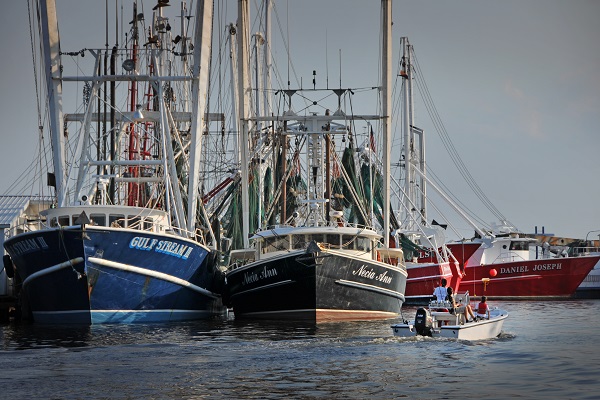
Increasing conflicts between commercial and recreational fishermen helped spur the legislation. Photo by Roger Winstead/NC State Communications.
“We had this regulation passed, that regulation passed. I called it ‘regulation by ambush.’ There was no rhyme or reason to it,” recalled recreational fisherman and Selma attorney Bob Lucas, describing how management decisions were made when he became chair of the N.C. Marine Fisheries Commission in 1993.
Management challenges were snowballing. Commercial-fishing landings had declined and uncertainty about the health of fish stocks loomed large. Massive fish kills due to pollution were occurring on the Neuse and other rivers.
Conflicts between commercial and recreational fishermen were becoming more common. Environmental advocates worried that pressure on fish stocks could reach a tipping point if commercial fishermen from states that had adopted net bans moved to North Carolina.
“A number of issues were on the table at that time, but the largest issue was that of controlling fishing effort and the fear that the numbers of commercial fishermen were going to rise drastically,” said Jerry Schill, who was executive director of the commercial-fishing trade organization, the North Carolina Fisheries Association.
Confidence in the state’s ability to protect fish stocks had plummeted.
“We had a Marine Fisheries Division that, from my perspective, was totally incompetent, and a Fisheries Commission that seemed either so pro-commercial or conversely pro-sport, that there was never any ability to come together around consensus,” explained now former governor Beverly Perdue. She represented Craven, Carteret and Pamlico counties in the North Carolina Senate in the 1990s.
Last year, Perdue, Schill, Lucas and other key figures in North Carolina fisheries talked about the successes, shortcomings and future capacity of the landmark legislation. Researchers working on the 1997 North Carolina Fisheries Reform Act: An Oral History project also asked them about the environmental and social conditions that gave rise to the changes.
UNCOVERING HISTORY
Interviewees were selected based on the depth of their personal involvement with the Reform Act and their willingness to participate, as well as how they represented the diversity of stakeholders involved in the legislation.
The recorded oral history interviews and a series of podcasts, featuring excerpts from the recordings, are now available online. The N.C. Community Collaborative Research Grant Program — supported by North Carolina Sea Grant in partnership with the William R. Kenan Jr. Institute for Engineering, Technology and Science — funded the project.
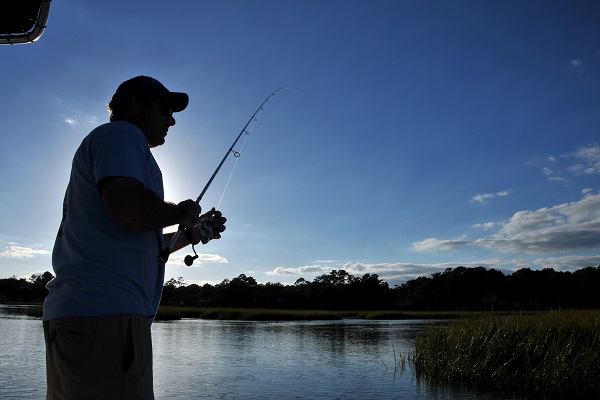
Interviewees represented the diversity of stakeholders involved in creation of the Reform Act. Photo by Roger Winstead/NC State Communications.
Collaborators brought knowledge of the management process and coastal ecosystems, and skills in oral history interviewing, archival science and audio podcasting to the project. I was principal investigator. Jimmy Johnson, coastal habitats coordinator with the Albemarle-Pamlico National Estuary Partnership, was co-principal investigator.
I had served on the N.C. Fisheries Moratorium Steering Committee, a group of 19 legislators, scientists, resource managers and fishermen appointed by the state legislature in 1994. We oversaw a study of the fisheries management process while a moratorium on new, nonemergency fishing regulations and the sale of new commercial fishing licenses was in place.
“The tension was so high that the only thing that we could do was move forward with some kind of legislation that would at least put a hiatus out there, a brief timeout where we could intelligently, and perhaps without emotion, evaluate where we were and where we wanted to go as a state,” Perdue said in her interview, describing why legislators instituted the moratorium.
The study committee’s recommendations on ways to improve the management process set the pace for Reform Act negotiations.
Johnson’s background includes chairmanship of the Marine Fisheries Commission shortly after the act became law. Under his leadership, the first comprehensive fishery management plan was developed for the blue crab fishery, the most valuable commercial fishery in the state.
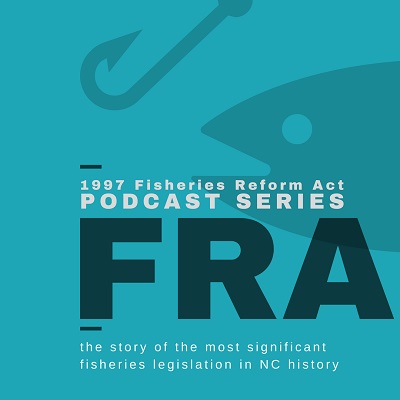
Bit & Grain helped develop a podcast series based on the oral history interviews.
Project team member Barbara Garrity-Blake, cultural anthropologist and adjunct professor at Duke University Marine Lab, also had served on the Moratorium Steering Committee and later on the Marine Fisheries Commission, where she co-chaired the habitat and water quality advisory committee.
Archivist and public historian Mary Williford transcribed the interviews and cataloged the recordings and transcriptions in an online collection. Karen Amspacher, Core Sound Waterfowl Museum and Heritage Center executive director, supplied the Carolina Coastal Voices website as a repository for the collection.
The team created a variety of online educational products, including a podcast series and discussion guide, to facilitate public access to the interviews.
Sandra Davidson, Ryan Stancil and Baxter Miller, founders of Bit & Grain, a digital documentary publication, produced the podcasts. The three episodes examine the state of fisheries in the early 1990s, explore the path from the moratorium to law, and look at the act’s successes and shortcomings. Each episode is less than 25 minutes long and can be played on a computer or smartphone.
FINDING THEMES
Team members also analyzed the content of the interviews, identifying points of agreement, disagreement and recurrent themes.
The analysis showed strong overall confidence in the Reform Act as a management framework for protecting coastal fishery resources and for balancing the interests of different stakeholder groups. Faith in the capacity of the act, however, didn’t blind interviewees to ideas for improvement or concern that key tenets had fallen to the wayside in the 20 years since its passage.
“The blueprint, if you will, of the Fisheries Reform Act, even today, will work. It will work. But you have to follow it. And even though it’s there, there’s still that human inclination to want to bypass it,” Lucas cautioned.
Other interviewees, including Jess Hawkins, a former Division of Marine Fisheries employee who was the liaison between the agency and the Marine Fisheries Commission, voiced concern that opportunities for citizen participation have been reduced in recent years.
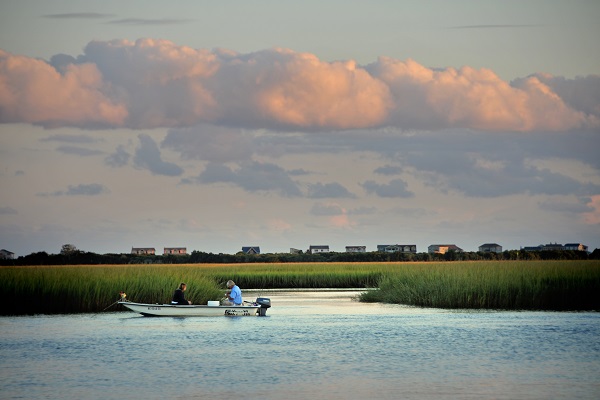
Concern for weakened water-quality measures since passage of the Reform Act was a recurrent interview theme. Photo by Roger Winstead/NC State Communications.
“The Fisheries Reform Act is not fulfilling what its visionaries had intended it to be. Some advisory committees were eliminated. The committees no longer meet frequently to try to be progressive and proactive in dealing with issues. They became reactive,” Hawkins said.
Interviewees agreed that fishery management plans supported by strong scientific evidence are the keystone of the act.
“The greatest success of the Reform Act is managing fisheries by management plan, and not by guess and by gosh,” said Dick Brame, executive director of the N.C. Coastal Conservation Association, a recreational fishing group, from 1989 to 1999.
“But fishery populations are moving, and we have to be able to adapt and be able to manage fisheries we have never seen before, and we are going to lose fisheries that we’ve had for a long time. Managing by fishery management plan hopefully would promulgate that,” Brame continued.
Dan Whittle’s assessment of the moratorium process was echoed in other interviews. Whittle, a policy advisor in state government until 1999, reflected, “What the Moratorium Steering Committee did was to convene gatherings where people came and could be heard, could talk and could be listened to. That was a valuable lesson, and it showed that what appeared to be irreconcilable differences were not that irreconcilable. It was a very effective tool. I think the biggest lesson is one of process, starting off by saying everyone has a legitimate interest in this policy debate, everyone needs to be heard.”
Concern that water quality and habitat protection measures have weakened since the Reform Act also was a recurrent theme.
“There’s less water-quality testing, less restrictions on stormwater runoff, less protection of marshlands and wetlands when it comes to building and developing, and those were things critical to the Coastal Habitat Protection Plan requirement in the Fisheries Reform Act. You can’t keep mitigating loss of environment by clamping down on the fishermen,” said Sandy Semans Ross, communications director for the N.C. Fisheries Association during development of the Reform Act.
In February and March 2017, the research team played the podcasts for focus groups at three coastal locations and at NC State University in Raleigh. Sara Mirabilio, fisheries specialist with Sea Grant, helped put together two of the sessions.
“We were able to question participants about their motivations for participating in the sessions, lessons learned from the podcast and suggestions for improving similar outreach products,” Mirabilio explains. “This invaluable feedback will help us tailor Sea Grant’s fisheries extension activities and cooperative research efforts so they remain highly relevant to stakeholders across the state.”
The sessions drew 50 participants, most of whom had little or no prior understanding of the Reform Act. After listening to a podcast episode, participants completed a short survey designed to gauge comprehension of the content. The podcasts proved to be an effective means of communication and sparked thoughtful discussion about resource management at the sessions.
KEY TAKEAWAYS
Team members also shared personal thoughts on lessons learned from the podcasts and interviews.
As the podcast narrator, Bit & Grain’s Stancil became very familiar with the content during rehearsal and in studio retakes. “The podcast storytelling taught me that fisheries management is about much more than allocation. It emboldened me to more thoughtfully consider the roles of water quality, coastal habitat and other environmental factors in the health of a vibrant, sustainable fishery,” Stancil says.
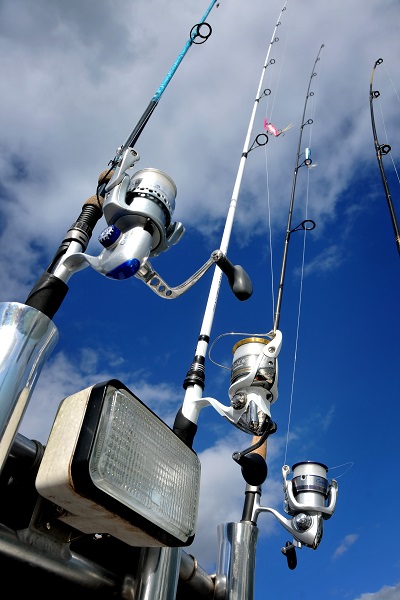
Researchers hope their work will stimulate further conversations about the future of fisheries management in the state. Photo by Roger Winstead/NC State Communications.
Williford was in elementary school when the Reform Act passed. “Hearing how things were before the act was very eye-opening. It gave me a much better understanding of why many stakeholders felt an urgency to impose some greater order on fisheries management in the state, and insight into how enforcement of the law has changed over time,” she says.
Folklorist Davidson of Bit & Grain reflects, “The oral histories revealed some policy drama, but they also revealed the unglamorous, tedious aspects of the democratic process. I was moved by how many citizens were willing to get down in the trenches to make this legislation happen.”
Davidson walked away from the project with mixed feelings. “Pride that our state intentionally engaged citizens in the reform process and that so many citizens rose to the challenge. Inspiration that government could look like this, and loss because the political process seems to have moved away from embracing this type of citizen participation,” she notes.
The podcasts were used this spring in the marine fisheries policy class Garrity-Blake teaches at Duke.
“The podcast was a wonderful teaching tool. Listening to the voices and viewpoints of people involved in development of the Fisheries Reform Act really brought the process to life for the students,” Garrity-Blake says.
Producers of CoastLine, a news program on WHQR public radio in Wilmington, relied on the podcasts as a resource in preparation for a broadcast about the Reform Act, featuring four of the project interviewees.
“I listened to the three-part podcast and was deeply impressed by how well all the divergent threads were pulled together into a comprehensive, fascinating, richly cultured narrative,” notes Rachel Lewis Hilburn, CoastLine host.
Researchers anticipate that the podcasts and other materials will be used in more classrooms and public forums.
“In our interview with Gov. Beverly Perdue, she insisted that it was the public’s duty, not the legislature’s duty, to make sure fisheries management stays on the agenda. This project helps do just that,” Williford says.
Susan West is a journalist and story collector, and a principal investigator of the Fisheries Reform Act oral history project. She is co-manager of Raising the Story, a collaborative program that strives to make research and scholarship relevant to contemporary life in creative ways. West also helped to establish Coastal Voices, an Outer Banks oral history project.
Listen & Learn
The podcasts, a discussion guide, and links to interview recordings and transcripts at both Carolina Coastal Voices and NOAA’s Voices from the Fisheries are available at raisingthestory.com. The interviewees and their roles during development and implementation of the Reform Act were:
- Dick Brame, N.C. Coastal Conservation Association executive director
- B.J. Copeland, North Carolina Sea Grant director, Moratorium Steering Committee member, N.C. Marine Fisheries Commission member
- Mac Currin, N.C. Marine Fisheries Commission member
- Jess Hawkins, N.C. Division of Marine Fisheries liaison to N.C. Marine Fisheries Commission
- Bob Lucas, Moratorium Steering Committee chair, N.C. Marine Fisheries Commission chair
- Pam Davis Morris, Carteret County Fishermen’s Association member
- Beverly Perdue, N.C. Senator
- Willy Phillips, N.C. Crabbers League of Aware Watermen co-founder
- Sandy Semans Ross, N.C. Fisheries Association communications director
- Jerry Schill, N.C. Fisheries Association executive director
- Melvin Shepard, Moratorium Steering Committee member
- Frank Tursi, Winston-Salem Journal reporter
- Dan Whittle, N.C. assistant secretary of natural resources’ policy advisor
Discussion Guide Excerpt
One outcome of the oral history project was a discussion guide created as a starting point for conversations about the Fisheries Reform Act. Here are some of the questions included in the guide:
- What did you learn about fisheries management that you did not know before listening to the podcasts? Did the podcasts change the way you think about fisheries management? Why or why not?
- The period prior to the moratorium was replete with environmental, economic and social issues. Which issues has the Fisheries Reform Act addressed successfully? What types of issues still pose challenges for fishery managers?
- The podcasts use excerpts from oral history interviews to tell listeners the story of why and how public policy developed. How important is it for current policymakers and stakeholders to understand the history of the Fisheries Reform Act?
This article was published in the Summer 2017 issue of Coastwatch.
For contact information and reprint requests, visit ncseagrant.ncsu.edu/coastwatch/contact/.
